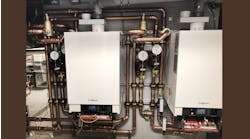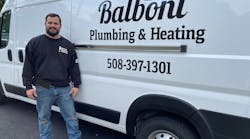BOSTON, MA — Brian Balboni’s father, Tom, founded Balboni Plumbing & Heating in 1970. He ran the business in Wellesley, MA, for 37 years before giving away all of his work and retiring. He didn’t know Brian would start the family business back up again some 11 years later.
Joining the US Marine Corps in 2008, Brian Balboni spent three deployments in Afghanistan training Afghan National Army soldiers, a task he resumed at Camp Pendleton, near San Diego, when he returned stateside. He left the military as an E5 sergeant in 2016.
Balboni explains that the military gave him the work ethic and sense of responsibility needed to run a successful company. His platoon included 190 troops, so he learned to lead.
“After I got out of the Marine Corps, I worked for a pipeline company in California as lead pipelayer for two years,” said Balboni. “My background was in plumbing, so everything was intuitive.”
In 2018, when his mother was diagnosed with cancer a second time, Balboni moved back to New England to rebuild Balboni Plumbing & Heating, with a focus on boiler work.
“I got my Journeyman license immediately upon returning to Mass,” said Balboni. “I had all the paperwork done before enlisting. I’d just never taken the test. I took online courses from Masters Plumbing & Gas School to freshen up, and the rest is history.”
Back to Boston
Today, Balboni Plumbing & Heating serves Boston’s Metro West, and they rarely leave Wellesley.
“I stay close to home because it makes life easier,” said Balboni. “Most of our work is residential, and we don’t do air conditioning work. I refuse to. People are grumpy when they’re hot. When they’re cold, they’re just happy you responded.”
“For example,” he continued, “Late one Christmas Eve I answered a no-heat call from a woman with a newborn. She had a six-year-old Alpine condensing boiler and didn’t know that condensing boilers should be serviced from time to time. It had never been cleaned. I serviced it, fired it up and calibrated it. On my way out the door, she gave me a hug.”
Strange Summer
Balboni is the owner, operator and sole employee of Balboni Plumbing & Heating, but he does partner with friends who own similar companies. They help each other out when the jobs get too big.
“In the summer, I usually try to find a new home construction project or two, but this year has been different,” said Balboni. “I’ve been installing a boiler every week. Like right now, I’m working on a big garage slab and driveway snowmelt system.”
A few weeks before that, Balboni called a friend to help him with a big retrofit on a system that hadn’t been touched in the past half century.
“I initially went to this home because the husband tried fixing a shower valve, breaking it in the process,” explained Balboni. “We got to talking and he showed me around the house. He asked if I did oil to gas conversions. When I told him that I did, regularly, we went to the basement.”
Gravity Fed
“I made a recommendation and gave him a quote in February,” said Balboni. “He wanted to wait until heating season was over to proceed. We tackled it in July when the family was on vacation and we knocked it out in six days.”
Two weeks before cutting out the monstrous pipe, Balboni injected the system with Fernox F3 cleaner to clean the radiators, which would remain in place. Two of them—luckily on the ground floor—were completely clogged, requiring them to be removed, power-flushed, sandblasted and repainted.
Once the whole hydronic system had been flushed and everything but the radiators had been removed, Balboni began re-installing the system.
Not Gravity Fed Anymore
“We installed a 210 MBH Aspen boiler,” said Balboni. “I install Alpines more often, simply because I know the unit like the back of my hand, but the Aspen offers everything the Alpine does in a slightly shallower cabinet. That was a plus here. The Alpine and the Aspen are simple to install, reliable, and many of the parts are interchangeable, like the flame sensor.”
“Plus,” he continued, “US Boiler Company has been around for so long that customers know the name. If they don’t directly request it, it’s an easy sell.”
The stainless steel, firetube Aspen boiler is also available in wall-hung models with capacities between 85 and 270 MBH and 320 and 399 MBH light commercial models are available for floor-mounted configurations. A 155 MBH combi is also available.
The system was zoned with Taco 007e circulators, and a magnetic Spirotherm Quad air and dirt separator was installed to clean the system and protect the circulators. The boiler and near-boiler piping were complete by day two.
Zones, Finally
“We broke up the system by floor, minus the first floor, which has a kitchen zone and a living room zone,” said Balboni. “I suggested that the second floor also have two zones, but the owners didn’t care if the master bedroom was lumped in with the rest of the floor. The third story is also one zone. The main supply and return lines for each zone are one-inch, with mono-flow tees diverting water to three-quarter-inch PEX for individual radiators. ”
Zoning the third floor was the toughest challenge. Originally, the supply and return for the third floor had been tapped off the second floor radiators. Balboni had to find these connections to cap them off. This included cutting small holes in the wall to locate the connections.
PEX supply and return lines were run to the basement. This alone took two days. The only other zone is a 60-gallon indirect water heater to replace the natural gas-fired tank.
Fernox F1 Protector was added to the system upon start-up. Balboni plans to flush it again early in the heating season simply because the radiators were so dirty.
Staggering Savings
“Our price for fuel oil here is extremely high,” said Balboni. “I’m surprised this system hadn’t already been converted to gas, considering there’s already a gas line to the house.”
The old boiler had a 275-gallon fuel tank, which the homeowner filled three times per winter, and that’s with the thermostat set to 62°F.
“They were spending $7,500 per year to heat the house, and that didn’t include DHW production,” said Balboni. “They probably won’t spend $1,000 on natural gas this year. Conservatively, that’s an annual savings of $6,500.”
The owners returned from vacation and the first thing the homeowner did was take a long shower, because, finally, he didn’t run out of hot water. They were impressed with the new system, but Balboni explained to them that they won’t even fully appreciate it until heating season arrives.
“The husband was blown away by how much new room was in the basement,” said Balboni. “He’s currently talking his wife into buying a pool table for that space. With their new energy savings, they can afford one!”
[The originally published version of this article mentioned Fernox F3 as the Protector and F1 as the Cleaner. CONTRACTOR regrets these errors. -- Ed.]




